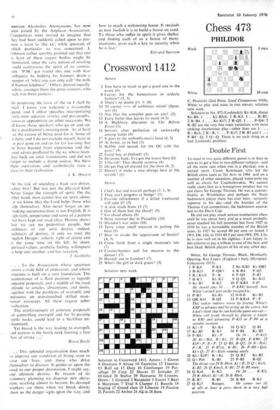Chess 473
PHILIDOR
C. Promislo (2nd Prize, Good Compatfons 1916). White to play and mate in two moves; solution next week.
Solution to No. 472 (Loshinski): Kt-Kt6, threat Kt-B4. 1 . . . Kt-B5ch; 2 R-K5. 1 . . . R-B5; 2 R-B4. 1 . . . Kt-Kt7; 2 R-Q5. 1 . . . P-Q4; 2 R-B2 are the very fine main variations with most striking interference play—other lines are 1 . . . Rx Rch; 2 B x R, 1 . P-Kt7; 2 R-B3 and 1 ... P-R8—Q; 2 QxQ. There is no such thing as a bad Loshinski problem.
Double First
To excel in two quite different games is at least as rare as to get a first in two different subjects—and all the more rare when one is a physical, one a mental sport. Cenek Kottnauer, who led the British chess team at Tel Aviv in 1964 and on a number of other occasions, played water-polo (as well as chess) for Czechoslovakia. We cannot really claim him as a homegrown product but we can claim Sir George Thomas. He was a quarter- finalist at Wimbledon and perhaps the finest badminton player there has ever been—certainly supreme in his day—and the founder of the Thomas Cup competition, the badminton equiva- lent to the Davis Cup.
He did not play much serious tournament chess until he was about forty and as a result probably never reached his full potential but from 1927 to 1939 he was a formidable member of the British team. In 1927 he scored 80 per cent on board 3 (W9, D6, LO), in 1931 69.5 per cent (W8, D9, LI); he is now well on in his eighties—I am happy in this column to pay a tribute to one of the best, and best liked, British players of his or any other day.
White, Sir George Thomas. Black, Monticelli. Opening, Ruy Lopez. (England v Italy, Olympiad, Folkestone 1933).
1 P-K4 P-K4 2 Kt-KB3 Kt-Q83 3 B-Kt5 P-QR3 4 B-R4 P-Q3 5 BxKtch PxB 6 P-Q4 P-B3 7 B-K3 Kt-K2 8 Q-Q2 Kt-Kt3 9 Kt-B3 B-K2 10 P-KR4 0-0?
He should play 10 . . . P-KR4! himself. Now White's attack gets on far too quickly.
11 P-R5 Kt-RI 12 0-0-0 Kt-B2 13 QR-Ktl B-Q2 14 P-KKt4 Px P This makes matters worse by freeing While's KBP to advance and by giving up the centre, but I don't think that he can hold the game anyway— White will break through by playing a knight to K B5 and advancing P-Ku5 or P-R6 at a suitable moment.
15 Kt x P Kt-K4 16 Q-K2 Q-B1 17 Kt-B5 R-K1 18 P-B4 Kt-82
19 P-R6! Kt xP Or /9. . . P-Kt3; 20 Ktx Bch, Rx Kt; 21 B-Q4, P-KB4; 22 KtP x P. BxP; 23 Q-B3, B-Q2; 24 RxPch!, Px R; 25 P-R7ch, K-B!; 26 P-R8--,--Qch, Kt x Q; 27 R x Ktch winning easily.
20 Kt x KtP! K x Kt 21 Q-R2 Kt-B2
22 Q x Pch K-B! 23 P-B5 B-Q1 The threat was 24 B-R6ch, Kt X B; 25 Q x Ktch, K-B2; 26 Q-Kt6ch, K-BI; 27 R-R8 mate.
24 Q-Kt6 K-K2 Or 24. . R-K2; 25 R-R8ch!, Kt x R; 26 B-R6ch.
25 R-R7 R-B1 26 B-R6 B-K1 27 Q-Kt7 Resigns. He comes out (if at all) at least a piece down in a very bad position.


































 Previous page
Previous page